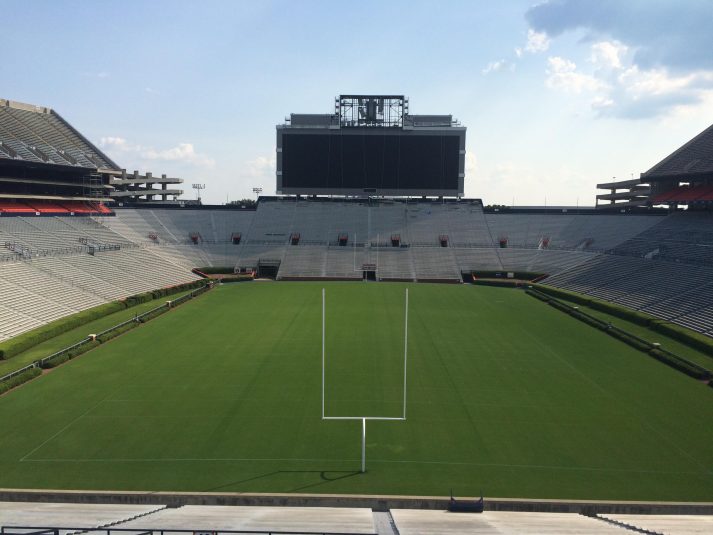Giant Videoboards in College Stadiums Pose Big Challenges for Sound Systems
Story Highlights
College sports venues have engaged in a long-running battle of size. The largest of them dwarf NFL venues: the University of Michigan’s Michigan Stadium seats nearly 110,000 — more than the populations of Cambridge, MA, or Allentown, PA — and stadiums at Alabama, Tennessee, Ohio State, and Penn State each seat well over 100,000 fans. And their price tags run well into nine figures, with expansions at Texas A&M and Notre Dame costing more than $400 million each.
The bigger bowls also boast bigger screens. Last year, Auburn University’s Jordan-Hare Stadium — the tenth-largest on-campus football stadium in the NCAA, with seats for 87,451 — became home to the largest HD videoboard in college sports: a massive 10,830-sq.-ft. LED video display (replacing a 2,200-sq.-ft. screen), which hosts a JBL VLA sound system.
A byproduct of these huge video displays, however, is that audio for those stadiums is struggling to keep up.
Construction, Sound, and Weather Issues
“Just physically, it’s a challenge getting the [components] up there into and onto the screens,” explains Mike Maloney, a regional sales rep for Daktronics, which manufactures and installs the majority of collegiate-stadium screens and increasingly integrates their audio as well, including the videoboard and sound at Auburn. “They reach a certain point, and you encounter very specific issues.”

Auburn University’s Jordan-Hare Stadium has a 10,830-sq.-ft. LED video display with a JBL VLA sound system.
Those issues include rattles and other vibrations — exacerbated by the increasing number of subwoofers needed to accurately reproduce contemporary pop music — that can literally tear a scoreboard apart if they’re wrongly calculated. Maloney recalls projects several years ago in which the vibrations from integrated sound systems knocked the power supplies off the back of the LED panels that make up large-scale videoboards. Connections between the panels are often serially daisy-chained, so the dislocation of just a few panels or power supplies can disrupt the entire board.
Weather is another factor that has to be accommodated. Speaker parts, such as metal grills, constantly exposed to the elements are subject to corrosion, and large videoboards can act like sails in high winds. Furthermore, the sound from the point-source audio systems that most collegiate videoboards deploy can be dramatically altered by winds between the speakers and the far ends of the stadiums.
Wind and sheer size sometimes require the use of delay towers: speakers located downrange of the main point-source arrays, with a wired audio signal traveling at nearly the speed of light, are delayed to allow the airborne sound, poking along at about 600 mph, time to catch up.
For very large stadiums, some designers resort to distributed sound-system designs. According to Maloney, Daktronics is working on such as design for a new sound system at Ole Miss’s Vaught-Hemingway Stadium. Although distributed sound systems are not uncommon in sports venues like baseball parks, they are almost never seen in collegiate bowls because of their expense — they require thousands of speakers throughout a venue that may be used fewer than a dozen times a year — and they create a logistical challenge because there are few surfaces on which to install them.
“College stadiums are wide open spaces,” he explains, “and there are few overhangs or other architectural elements to attach speakers to.”
Mike Hedden, president of Danley Sound Labs, which has installed sound systems in huge venues at LSU and Arizona State, among others, notes that, as the costs of stadium construction, expansion, and maintenance increase, monster scoreboards add more advertising elements. These can help offset costs but can also reduce available space for sound systems.
“The real issue is, as the boards get bigger, it allows for more advertising, so the space allocated for audio is always looking to be shrunk to maximize ad dollars,” he says. Danley’s product designs, he adds, have been adapted to produce more acoustic output from smaller speaker enclosures, which also reduce overall weight.
Sound-system design seeks size and weight efficiencies wherever they can be found these days. One place is networked audio. Auburn’s new sound system, for example, deploys a Dante network to eliminate weight from copper cabling, using fiber cabling instead. Dante also routes audio over IP from a Midas mixing console in Auburn University’s video-control room, a half mile up the road from the stadium.
At the end of the day, though, bigger stadiums need bigger A/V, and what had been conventional systems-integration projects increasingly are themselves major construction events.
“It’s a major effort, with huge cranes, working with general contractors and electrical contractors now, not just A/V-systems integrators,” says Maloney. “At this scale, these projects can’t be done by just anyone anymore.”
